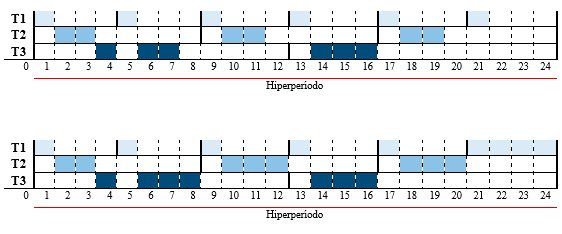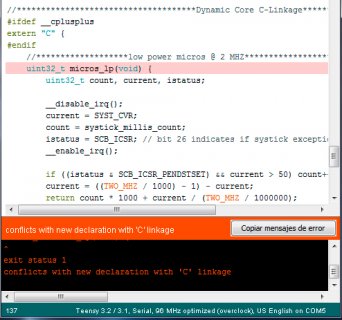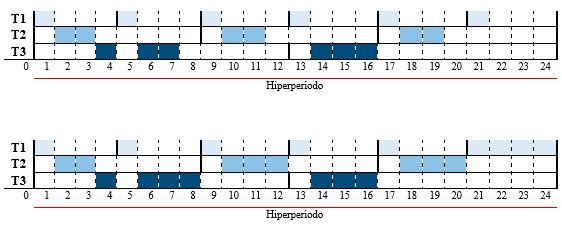/***************************************
* REDUCED_CPU_BLOCK allows you to run
* code at 2 MHz (VLPR). See micro_lp and
* delay_lp to see how to convert core
* functionality at F_CPU to work at 2 MHz.
****************************************/
#include <Snooze.h>
//*************************************Dynamic Core C-Linkage**************************************
#ifdef __cplusplus
extern "C" {
#endif
//*******************low power micros @ 2 MHZ*************************
uint32_t micros_lp(void) {
uint32_t count, current, istatus;
__disable_irq();
current = SYST_CVR;
count = systick_millis_count;
istatus = SCB_ICSR; // bit 26 indicates if systick exception pending
__enable_irq();
if ((istatus & SCB_ICSR_PENDSTSET) && current > 50) count++;
current = ((TWO_MHZ / 1000) - 1) - current;
return count * 1000 + current / (TWO_MHZ / 1000000);
}
//*******************low power delay_lp @ 2 MHZ************************
void delay_lp(uint32_t ms) {
uint32_t start = micros_lp();
if (ms > 0) {
while (1) {
if ((micros_lp() - start) >= 1000) {
ms--;
if (ms == 0) return;
start += 1000;
}
yield();
}
}
}
#ifdef __cplusplus
}
#endif
void setup() {
pinMode(LED_BUILTIN, OUTPUT);
}
void loop() {
SOS(); // F_CPU
/*
* code inside this macro
* will run at 2 MHz.
* code outside will run
* at whatever F_CPU you
* compiled at.
*/
REDUCED_CPU_BLOCK() {
SOS_LP();// 2 MHz
}
}
// SOS from http://www.thejamesjones.com/blog/make-your-arduino-blink-sos
void SOS() {
digitalWrite(LED_BUILTIN, HIGH); // turn the LED_BUILTIN on (HIGH is the voltage level)
delay(0250); // wait for a second
digitalWrite(LED_BUILTIN, LOW); // turn the LED_BUILTIN off by making the voltage LOW
delay(0250); // wait for a second
digitalWrite(LED_BUILTIN, HIGH); // turn the LED_BUILTIN on (HIGH is the voltage level)
delay(0250); // wait for a second
digitalWrite(LED_BUILTIN, LOW); // turn the LED_BUILTIN off by making the voltage LOW
delay(0250); // wait for a second
digitalWrite(LED_BUILTIN, HIGH); // turn the LED_BUILTIN on (HIGH is the voltage level)
delay(0250); // wait for a second
digitalWrite(LED_BUILTIN, LOW); // turn the LED_BUILTIN off by making the voltage LOW
delay(0600); // wait for a second
digitalWrite(LED_BUILTIN, HIGH); // turn the LED_BUILTIN on (HIGH is the voltage level)
delay(1000); // wait for a second
digitalWrite(LED_BUILTIN, LOW); // turn the LED_BUILTIN off by making the voltage LOW
delay(0250); // wait for a second
digitalWrite(LED_BUILTIN, HIGH); // turn the LED_BUILTIN on (HIGH is the voltage level)
delay(1000); // wait for a second
digitalWrite(LED_BUILTIN, LOW); // turn the LED_BUILTIN off by making the voltage LOW
delay(0250); // wait for a second
digitalWrite(LED_BUILTIN, HIGH); // turn the LED_BUILTIN on (HIGH is the voltage level)
delay(1000); // wait for a second
digitalWrite(LED_BUILTIN, LOW); // turn the LED_BUILTIN off by making the voltage LOW
delay(0250); // wait for a second
digitalWrite(LED_BUILTIN, HIGH); // turn the LED_BUILTIN on (HIGH is the voltage level)
delay(0250); // wait for a second
digitalWrite(LED_BUILTIN, LOW); // turn the LED_BUILTIN off by making the voltage LOW
delay(0250); // wait for a second
digitalWrite(LED_BUILTIN, HIGH); // turn the LED_BUILTIN on (HIGH is the voltage level)
delay(0250); // wait for a second
digitalWrite(LED_BUILTIN, LOW); // turn the LED_BUILTIN off by making the voltage LOW
delay(0250); // wait for a second
digitalWrite(LED_BUILTIN, HIGH); // turn the LED_BUILTIN on (HIGH is the voltage level)
delay(0250); // wait for a second
digitalWrite(LED_BUILTIN, LOW); // turn the LED_BUILTIN off by making the voltage LOW
delay(1000); // wait for a second
}
void SOS_LP() {
digitalWrite(LED_BUILTIN, HIGH); // turn the LED_BUILTIN on (HIGH is the voltage level)
delay_lp(0250); // wait for a second
digitalWrite(LED_BUILTIN, LOW); // turn the LED_BUILTIN off by making the voltage LOW
delay_lp(0250); // wait for a second
digitalWrite(LED_BUILTIN, HIGH); // turn the LED_BUILTIN on (HIGH is the voltage level)
delay_lp(0250); // wait for a second
digitalWrite(LED_BUILTIN, LOW); // turn the LED_BUILTIN off by making the voltage LOW
delay_lp(0250); // wait for a second
digitalWrite(LED_BUILTIN, HIGH); // turn the LED_BUILTIN on (HIGH is the voltage level)
delay_lp(0250); // wait for a second
digitalWrite(LED_BUILTIN, LOW); // turn the LED_BUILTIN off by making the voltage LOW
delay_lp(0600); // wait for a second
digitalWrite(LED_BUILTIN, HIGH); // turn the LED_BUILTIN on (HIGH is the voltage level)
delay_lp(1000); // wait for a second
digitalWrite(LED_BUILTIN, LOW); // turn the LED_BUILTIN off by making the voltage LOW
delay_lp(0250); // wait for a second
digitalWrite(LED_BUILTIN, HIGH); // turn the LED_BUILTIN on (HIGH is the voltage level)
delay_lp(1000); // wait for a second
digitalWrite(LED_BUILTIN, LOW); // turn the LED_BUILTIN off by making the voltage LOW
delay_lp(0250); // wait for a second
digitalWrite(LED_BUILTIN, HIGH); // turn the LED_BUILTIN on (HIGH is the voltage level)
delay_lp(1000); // wait for a second
digitalWrite(LED_BUILTIN, LOW); // turn the LED_BUILTIN off by making the voltage LOW
delay_lp(0250); // wait for a second
digitalWrite(LED_BUILTIN, HIGH); // turn the LED_BUILTIN on (HIGH is the voltage level)
delay_lp(0250); // wait for a second
digitalWrite(LED_BUILTIN, LOW); // turn the LED_BUILTIN off by making the voltage LOW
delay_lp(0250); // wait for a second
digitalWrite(LED_BUILTIN, HIGH); // turn the LED_BUILTIN on (HIGH is the voltage level)
delay_lp(0250); // wait for a second
digitalWrite(LED_BUILTIN, LOW); // turn the LED_BUILTIN off by making the voltage LOW
delay_lp(0250); // wait for a second
digitalWrite(LED_BUILTIN, HIGH); // turn the LED_BUILTIN on (HIGH is the voltage level)
delay_lp(0250); // wait for a second
digitalWrite(LED_BUILTIN, LOW); // turn the LED_BUILTIN off by making the voltage LOW
delay_lp(1000); // wait for a second
}





